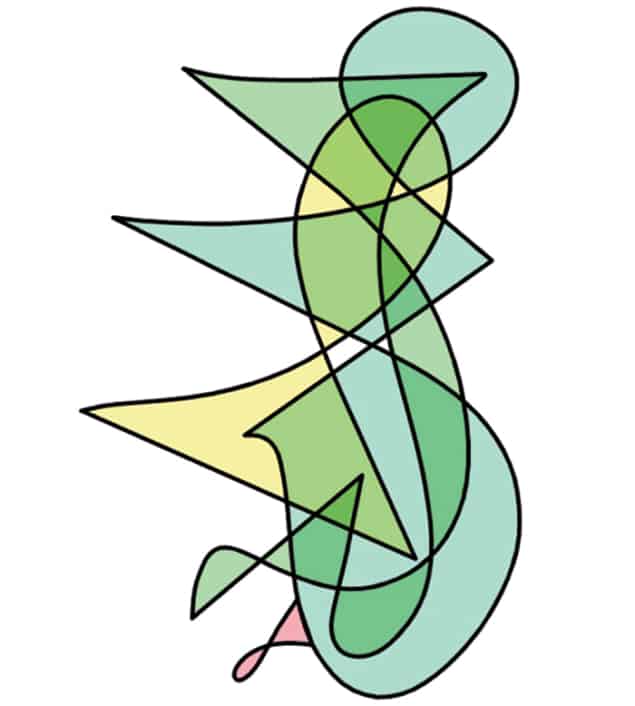Mathematical doodles, the “new space” era and a pocket guide to astronomy, reviewed by Margaret Harris

Mathematical doodling
The next time you find yourself idly sketching loops and curves on a notepad, Tim Chartier has a request: he wants you to turn your doodles into mathematics. A mathematician at Davidson College in North Carolina, US, Chartier is the author of Math Bytes, a grab-bag of a book that is full of quirky everyday applications of mathematics, including the aforementioned doodles. It turns out that any squiggle you create will obey the formula V + F – E = 2, where V is the number of vertices (the points at which lines intersect each other), F is the number of enclosed areas or faces (basically regions you could colour in) and E is the number of edges (the line segments between the vertices). The relationship between these numbers is called the Euler characteristic after the 18th century mathematician Leonhard Euler, who proved that it holds for all doodles. It has a number of applications, including as a test to determine whether a maze is solvable. Euler’s characteristic is also linked to the famous “travelling salesman problem”, which asks which of many possible paths one should take between a set of vertices in order to minimize the distance travelled along the edges. Conceptually speaking, this isn’t a hard problem to understand, but as Chartier explains, it is actually one of the most challenging puzzles in all of computational mathematics. Most of the chapters in Math Bytes likewise begin with simple set-ups and gradually move on to more complex ideas, and this (plus the large number of hands-on examples) make it a handy guide for anyone involved in science or mathematics outreach.
- 2014 Princeton University Press £16.95/$24.95hb 152pp
Exploring spirit
Here’s a back-of-the-envelope problem for the rocket scientists reading this: how much conventional rocket fuel would it take to deliver a Space-Shuttle-sized payload from Earth to the Alpha Centauri system in less than 1000 years? The answer – and many other interesting facts concerning the past, present and future of space exploration – can be found in Beyond, a new book written by Chris Impey. An astronomer and popular-science author, Impey makes an affable and generally even-handed guide to this fascinating subject, balancing rhetoric about humankind’s restless curiosity with sober assessments of what is and is not possible. The book refers, vividly, to “the tyranny of the rocket equation”, while the immense cost and long time period required to terraform Mars or send humans to another star are laid out with a fine, clear blend of optimism and realism. The one sour note in Beyond concerns its treatment of “new space” entrepreneurs such as Burt Rutan and Richard Branson. The book was already in press in October 2014, when one of Rutan’s pilots, Michael Alsbury, was killed during a test flight for Branson’s Virgin Galactic project, so it is not Impey’s fault that this setback is barely mentioned. Even so, in light of Alsbury’s death and the still-incomplete investigation into its causes, readers may find it a trifle jarring to read fawning descriptions of Branson’s buccaneering attitude and Rutan’s “entrepreneur’s impatience with red tape”. (After all, what are safety regulations but a form of red tape?) Once Impey finishes gushing about the “breathtaking passion” of these charismatic figures, though, his overall assessment of “new space” is fair-minded and insightful. Far from being moribund, today’s space industry, Impey argues, “may now be where the Internet was in 1995, ready to soar”. Now isn’t that an exciting thought?
- 2015 W W Norton £16.99/$27.95hb 336pp
Astrofacts at your fingertips
What’s the reddest object in our solar system? Surprisingly, the answer isn’t Mars but a denizen of the Oort cloud called Sedna. This icy, rocky object resembles Pluto except for the high proportion of carbon-based chemicals mixed into its crust, which account for its reddish hue. Sedna’s other claim to fame is that it is currently the most distant object we know of in the solar system: located well outside the orbits of Uranus and Neptune, it orbits the Sun on a highly elliptical path that will eventually take it out to a point that is 937 times farther from the Sun than the Earth is now. As such, Sedna’s reddish glow isn’t going to be readily apparent to backyard stargazers, so it’s not immediately obvious why it deserves its own entry in the pages of Astronomy in Minutes, a pint-sized guide that promises to explain the night sky “in an instant”. Look more closely, though, and you will see that the book’s small size belies its scope. Written by the astronomer and science communicator Giles Sparrow, Astronomy in Minutes includes brief summaries of astrophysical topics such as variable stars, black holes and the H-R diagram of stellar evolution as well as practical stargazing tips. With individual descriptions of what to look for in 60 different constellations, plus some more complex material to whet the appetites of young enthusiasts, it’s definitely worth tucking into a backpack the next time you head out for a bit of stargazing.
- 2015 Quercus £8.99pb 416pp



